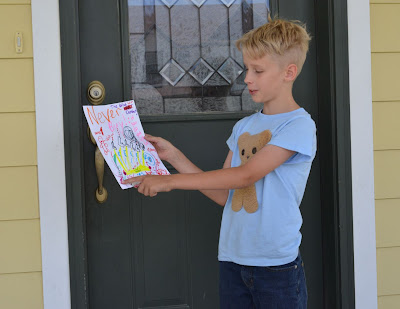I've made lots of types of candy before, but never taffy. I've always wanted to try it, though, having read about "Taffy pulls" in books (Little House on the Prairie? Or Betsy-Tacy or something like that?). So we set out to do so.
Along the way, I learned that my candy thermometer must be about 15 degrees off---which is weird, as it registered the right temperature for boiling water (204 at this altitude). Of course that means that though I took it off the heat at precisely the temperature the recipe specified, the taffy cooked way, way too hard---into hard, Werther's-type butterscotch, in fact. But that wasn't the first thing that went wrong; no, the first thing was that I looked away from the stove for a few minutes as we were making covered wagons and forgot the taffy, and it burned into horrible blackened sugar. Awful! Knowing how disappointed everyone would be, I said we'd start over---and this second time yielded our delicious, but very un-taffy-like, hard butterscotch.
I was NOT planning on a third attempt---but then, I just decided, the kitchen was already a mess---we already had a bunch of pots to wash---why not one more? "You're SOOOO nice," said grateful Abe as I started Taffy Attempt #3. I couldn't deny it.
This is the recipe we used, and we found it particularly helpful---more than the others we saw. Now that my trusty candy thermometer had let me down (I assume it was the thermometer and not the recipe---because the recipe is for the Lion House taffy, which means the altitude is the same as it is here. Otherwise I might have thought I needed to adjust the temp. for altitude, but nope.) I had to just watch the taffy and try to get it to the right color and consistency. The pictures accompanying the recipe helped me do so.
So, finally, it was perfect, and all we had to do was PULL the taffy! This was quite fun. The little ones got tired quickly (Daisy's piece never did really whiten) but the rest of us soldiered on. You have to pull for quite a long time to really make the taffy fluffy and white and soft! The pictures linked above, again, were very helpful in seeing what color of taffy we were aiming for.
The taffy turned out quite yummy. I don't think I love taffy enough to make it often, but maybe for a party or something it would be fun. Especially now that I know what consistency I am looking for when cooking it! And, we enjoyed imagining our pioneer ancestors watching and laughing at our pitiful efforts from on high. Good old-fashioned fun! :)


















































